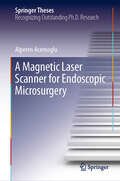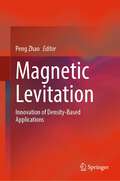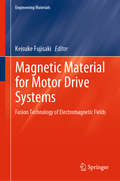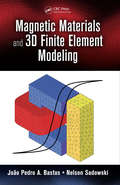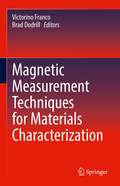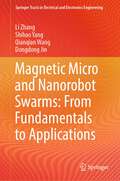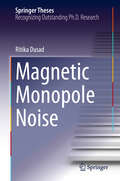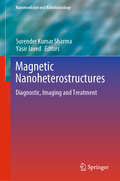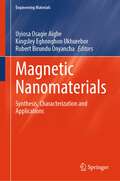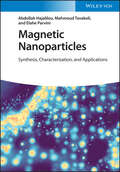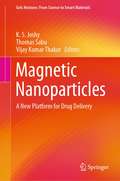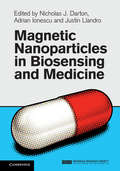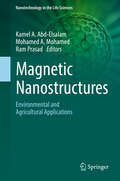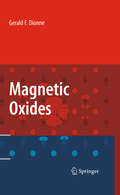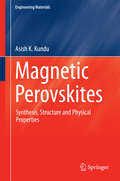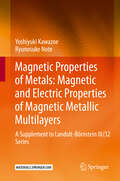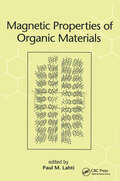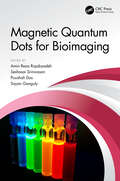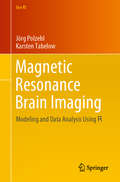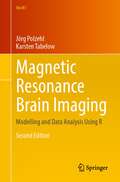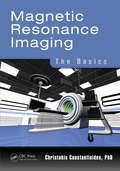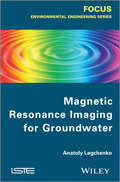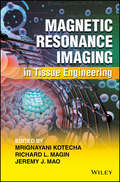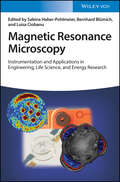- Table View
- List View
A Magnetic Laser Scanner for Endoscopic Microsurgery (Springer Theses)
by Alperen AcemogluThis book focuses on the design, development, and characterization of a compact magnetic laser scanner for microsurgical applications. In addition, it proposes a laser incision depth controller to be used in soft tissue microsurgeries.The use of laser scanners in soft tissue microsurgery results in high quality ablations with minimal thermal damage to surrounding tissue. However, current scanner technologies for microsurgery are limited to free-beam lasers, which require direct line-of-sight to the surgical site, from outside the patient. Developing compact laser micromanipulation systems is crucial to introducing laser-scanning capabilities in hard-to-reach surgical sites, e.g., vocal cords.In this book, the design and fabrication of a magnetically actuated endoscopic laser scanner have been shown, one that introduces high-speed laser scanning for high quality, non-contact tissue ablations in narrow workspaces. Static and dynamic characterization of the system, its teleoperation through a tablet device, and its control modelling for automated trajectory executions have been shown using a fabricated and assembled prototype. Following this, the book discusses how the laser position and velocity control capabilities of the scanner can be used to design a laser incision depth controller to assist surgeons during operations.
Magnetic Levitation: Innovation of Density-Based Applications
by Peng ZhaoThis book introduces the MagLev testing method for density measurement and density-based applications of diamagnetic and low-magnetic objects using permanent magnets. The book surveys the most relevant papers on the theory and model of various MagLev methods that have become the foundation to elucidate the principles of MagLev and the conditions for stable levitation. A thorough summary of the improvements demonstrates the applications and potential of the MagLev method in many fields. This book is separated into 11 chapters to present MagLev testing method fully, including a review of the background of MagLev, theories and basic principles of the stable levitation of object, different dimensions of applications of MagLev in the fields of mechanical engineering, chemistry, and bioengineering, and sophisticated applications of manipulation and separation. This book would benefit the audience in the field of mechanical engineering, chemistry, materials science, and bioengineering, since magnetic levitation method has proved itself suitable for the density-based analysis and applications of materials of different scales. The analysis in this book will help the audience deeply understand the mechanism of magnetic levitation, and it can serve as an instruction for the magnetic levitation procedure, or guidebook for the magnetic levitation setup. With the viewpoints and thoughts about MagLev running through this book, this book may spark the audience’s interest towards magnetic levitation method, and enlighten them to further develop Maglev method.
Magnetic Material for Motor Drive Systems: Fusion Technology of Electromagnetic Fields (Engineering Materials)
by Keisuke FujisakiThis book focuses on how to use magnetic material usefully for electrical motor drive system, especially electrical vehicles and power electronics. The contents have been selected in such a way that engineers in other fields might find some of the ideas difficult to grasp, but they can easily acquire a general or basic understanding of related concepts if they acquire even a rudimentary understanding of the selected contents.The cutting-edge technologies of magnetism are also explained. From the fundamental theory of magnetism to material, equipment, and applications, readers can understand the underlying concepts. Therefore, a new electric vehicle from the point of view of magnetic materials or a new magnetic material from the point of a view of electric vehicles can be envisioned: that is, magnetic material for motor drive systems based on fusion technology of an electromagnetic field. Magnetic material alone does not make up an electric vehicle, of course. Other components such as mechanical structure material, semiconductors, fuel cells, and electrically conductive material are important, and they are difficult to achieve. However, magnetic material involves one of the most important key technologies, and there are high expectations for its use in the future. It will be the future standard for motor-drive system researchers and of magneticmaterial researchers as well. This book is a first step in that direction.
Magnetic Materials
by Nicola A. SpaldinMagnetic Materials is an excellent introduction to the basics of magnetism, magnetic materials and their applications in modern device technologies. Retaining the concise style of the original, this edition has been thoroughly revised to address significant developments in the field, including the improved understanding of basic magnetic phenomena, new classes of materials, and changes to device paradigms. With homework problems, solutions to selected problems and a detailed list of references, Magnetic Materials continues to be the ideal book for a one-semester course and as a self-study guide for researchers new to the field. New to this edition: , Acents Entirely new chapters on Exchange Bias Coupling, Multiferroic and Magnetoelectric Materials, Magnetic Insulators, Acents Revised throughout, with substantial updates to the chapters on Magnetic Recording and Magnetic Semiconductors, incorporating the latest advances in the field, Acents New example problems with work
Magnetic Materials and 3D Finite Element Modeling
by João Pedro Bastos Nelson SadowskiMagnetic Materials and 3D Finite Element Modeling explores material characterization and finite element modeling (FEM) applications. This book relates to electromagnetic analysis based on Maxwell’s equations and application of the finite element (FE) method to low frequency devices. A great source for senior undergraduate and graduate students in electromagnetics, it also supports industry professionals working in magnetics, electromagnetics, ferromagnetic materials science and electrical engineering. The authors present current concepts on ferromagnetic material characterizations and losses. They provide introductory material; highlight basic electromagnetics, present experimental and numerical modeling related to losses and focus on FEM applied to 3D applications. They also explain various formulations, and discuss numerical codes. • Furnishes algorithms in computational language • Summarizes concepts related to the FE method • Uses classical algebra to present the method, making it easily accessible to engineers Written in an easy-to-understand tutorial format, the text begins with a short presentation of Maxwell’s equations, discusses the generation mechanism of iron losses, and introduces their static and dynamic components. It then demonstrates simplified models for the hysteresis phenomena under alternating magnetic fields. The book also focuses on the Preisach and Jiles–Atherton models, discusses vector hysterisis modeling, introduces the FE technique, and presents nodal and edge elements applied to 3D FE formulation connected to the hysteretic phenomena. The book discusses the concept of source-field for magnetostatic cases, magnetodynamic fields, eddy currents, and anisotropy. It also explores the need for more sophisticated coding, and presents techniques for solving linear systems generated by the FE cases while considering advantages and drawbacks.
Magnetic Measurement Techniques for Materials Characterization
by Victorino Franco Brad DodrillThis book discusses the most commonly used techniques for characterizing magnetic material properties and their applications. It provides a comprehensive and easily digestible collection and review of magnetic measurement techniques. It also examines the underlying operating principles and techniques of magnetic measurements, and presents current examples where such measurements and properties are relevant. Given the pervasive nature of magnetic materials in everyday life, this book is a vital resource for both professionals and students wishing to deepen their understanding of the subject.
Magnetic Micro and Nanorobot Swarms: From Fundamentals to Applications (Springer Tracts in Electrical and Electronics Engineering)
by Li Zhang Shihao Yang Qianqian Wang Dongdong JinThis book is focused on the attractive emerging field of micro-/nanorobot swarms (microswarms). It introduces fundamental understandings of various microswarms, including pattern generation, transformation, locomotion, and imaging. This book also demonstrates applications of micro-/nanorobot swarms in different fields, such as biomedical, environmental, and electrical applications. The detailed theoretical analysis and experimental demonstrations in this book provide readers ranging from students to researchers with a realistic picture of progress achieved in the field of micro-/nanorobot swarms.
Magnetic Monopole Noise (Springer Theses)
by Ritika DusadThis thesis presents the first ever measurement of the noise emitted by magnetic monopoles and the development of an exquisitely sensitive magnetic-field-noise spectrometer based on a superconducting quantum interference device (SQUID) that enabled it. Magnetic monopoles are highly elusive elementary particles exhibiting quantized magnetic charge. The prospects for studying them brightened recently with the theoretical discovery that the thermally excited states in certain classes of magnetic insulators exhibit all the characteristics of magnetic monopoles. Furthermore, in 2018, it was predicted that the random motion of magnetic monopoles inside would generate a very specific kind of magnetization noise. In this thesis, the author describes a new experimental technique, so-called spin noise spectroscopy, and the subsequent discovery of virtually all of the predicted features of the magnetic noise expected from a dense fluid of magnetic monopoles in crystals of Dy2Ti2O7. Remarkably, because this magnetic monopole noise occurs in the frequency range below 20kHz, when amplified by the SQUID it is actually audible to humans.
Magnetic Nanoheterostructures: Diagnostic, Imaging and Treatment (Nanomedicine and Nanotoxicology)
by Surender Kumar Sharma Yasir JavedThis book contains most updated information on synthesis of magnetic nanohybrids, their physio-chemical properties, and key biological applications. It highlights the complexity of nanoheterostructures, especially magnetic metal oxides, ferrites and doped magnetic nanomaterials, and discusses their potential applications in the early detection, imaging and treatment of cancer. It also covers the toxicity and risk assessment of multifunctional nanomaterials. Providing an overview of magnetic nanoheterostructures, it appeals to a wide audience, from beginners and graduate-level students to experts in academia and industry.
Magnetic Nanomaterials: Synthesis, Characterization and Applications (Engineering Materials)
by Uyiosa Osagie Aigbe Kingsley Eghonghon Ukhurebor Robert Birundu OnyanchaThis book explores some of the latest and recent advances in the synthesis, characterization and applications of magnetic nanomaterials. It starts with an overview of magnetic nanomaterials, followed by a list of their synthesis and characterization methods. The book shows the potential of magnetic materials in different applications, including theranostic nanomedicine, heavy metals detection, dyes sensing, solar cells, wastewater treatment, decontamination of soil, and detection and monitoring of toxic gases. Moreover, it explores their use as drug and gene delivery agents, their biosafety and bioregulation facets, tissue engineering applications, and their potential for combating pathogens
Magnetic Nanoparticles: Synthesis, Characterization, and Applications
by Abdollah Hajalilou Mahmoud Tavakoli Elahe ParviniMagnetic Nanoparticles Learn how to make and use magnetic nanoparticles in energy research, electrical engineering, and medicine In Magnetic Nanoparticles: Synthesis, Characterization, and Applications, a team of distinguished engineers and chemists delivers an insightful overview of magnetic materials with a focus on nano-sized particles. The book reviews the foundational concepts of magnetism before moving on to the synthesis of various magnetic nanoparticles and the functionalization of nanoparticles that enables their use in specific applications. The authors also highlight characterization techniques and the characteristics of nanostructured magnetic materials, like superconducting quantum interference device (SQUID) magnetometry. Advanced applications of magnetic nanoparticles in energy research, engineering, and medicine are also discussed, and explicit derivations and explanations in non-technical language help readers from diverse backgrounds understand the concepts contained within. Readers will also find: A thorough introduction to magnetic materials, including the theory and fundamentals of magnetization In-depth explorations of the types and characteristics of soft and hard magnetic materials Comprehensive discussions of the synthesis of nanostructured magnetic materials, including the importance of various preparation methods Expansive treatments of the surface modification of magnetic nanoparticles, including the technical resources employed in the process Perfect for materials scientists, applied physicists, and measurement and control engineers, Magnetic Nanoparticles: Synthesis, Characterization, and Applications will also earn a place in the libraries of inorganic chemists.
Magnetic Nanoparticles: A New Platform for Drug Delivery (Gels Horizons: From Science to Smart Materials)
by K. S. Joshy Thomas Sabu Vijay Kumar ThakurThis volume covers current research in the usage of magnetic nanoparticles for drug delivery. It discusses synthesis methods, stabilizers used for surface coating on MNPs, and potential target ligands which can be used to ferry payloads to the targeted disease region. It also highlights the factors affecting delivery efficiency and toxicity, as well as the different routes of administration. The content also focus on the use of these carriers for gene therapy and to target brain tumors. This volume will be of interest to researchers working on drug discovery and delivery platforms.
Magnetic Nanoparticles in Biosensing and Medicine
by Nicholas J. Darton Adrian Ionescu Justin LlandroDrawing together topics from a wide range of disciplines, this text provides a comprehensive insight into the fundamentals of magnetic biosensors and the applications of magnetic nanoparticles in medicine. Internationally renowned researchers showcase topics ranging from the basic physical principles of magnetism to the detection and manipulation, synthesis protocols and natural occurrence of magnetic nanoparticles. Up-to-date examples of their clinical usage and research applications in the biomedical fields of sensing by diverse magnetic detection methods, in imaging by MRI and in therapeutic strategies such as hyperthermia, are also discussed, providing a thorough introduction to this rapidly developing field. Each chapter features questions with answers, highlighted definition boxes, and numerous illustrations which help readers grasp key concepts. Mathematical tools, together with key literature references, provide a strong underpinning for the material, making it ideal for graduate students, lecturers, medical researchers and industrial scientific strategists.
Magnetic Nanostructures: Environmental and Agricultural Applications (Nanotechnology in the Life Sciences)
by Kamel A. Abd-Elsalam Mohamed A. Mohamed Ram PrasadRecently, magnetic nanostructures have gained a remarkable interest for basic research and applied studies. Because of their low cost and ease of manufacture and modification, they have great potential for agricultural and environmental applications. The use of magnetic nanostructures has been proven in a wide range of fields including catalysis, biotechnology, biomedicine, magnetic resonance imaging, agriculture, biosensors, and removal of environmental pollutants, among others. This book includes 16 chapters of collected knowledge, discoveries, and applications in agriculture, soil remediation, and water treatment. It describes the role of nano-agriculture with regard to food security and discusses environmental and agricultural protection concerns. It further offers potential applications of magnetic nanomaterials in the agriculture and food sectors, such as the development of sensors, environment monitoring for wastewater treatment and the remediation of contaminated soils. Increasing crop yield through the use of nanopesticides or nanofertilizers and biosecurity using sensors for detecting pathogens along the entire food chain are discussed as well. This book also brings together various sources of expertise on different aspects magnetic nanostructure application in the agri-food sector and environment remediation. Magnetic nanostructures also have great potential in biotechnological processes, as they can be utilized as a carrier for enzymes during different biocatalytic transformations. Novel magnetic nanomaterials can be used for detection and separation of pesticides from environmental and biological samples. The excellent adsorption capacity of the modified magnetic nanoadsorbents together with other advantages such as reusability, easy separation, environmentally friendly composition, and freedom of interferences of alkaline earth metal ions make them suitable adsorbents for removal of heavy metal ions from environmental and industrial wastes. One of the most important environmental applications of magnetic nanostructures has been in the treatment of water, whether in the remediation of groundwater or through the magnetic separation and/or sensing of contaminants present in various aqueous systems. The integrated combination of these 16 chapters, written by experts with considerable experience in their area of research, provides a comprehensive overview on the synthesis, characterization, application, environmental processing, and agriculture of engineered magnetic nanostructures. Its comprehensive coverage discusses how nanostructure materials interact in plants as well as their potential and useful applications.
Magnetic Oxides
by Gerald F. DionneMagnetic Oxides offers a cohesive up-to-date introduction to magnetism in oxides. Emphasizing the physics and chemistry of local molecular interactions essential to the magnetic design of small structures and thin films, this volume provides a detailed view of the building blocks for new magnetic oxide materials already advancing research and development of nano-scale technologies. Clearly written in a well-organized structure, readers will find a detailed description of the properties of magnetic oxides through the prism of local interactions as an alternative to collective electron concepts that are more applicable to metals and semiconductors. Researchers will find Magnetic Oxides a valuable reference.
Magnetic Perovskites
by Asish K. KunduMagnetic perovskite with multifunctional properties (magneto-resistive,magneto-dielectric, multiferroics, spintronics, etc. ) have attracted increasingattention due to their possible applications towards storage materials andintriguing fundamental Physics. Despite the numerous investigations onmultifunctional materials in the past few years, a very few magneticperovskites have been known to realize as ferromagnetic-insulators. In perovskitescentred transition metal oxides strong interplay between lattice, charge, spinand/or orbital degrees of freedom provide a fantastic playground to tune theirphysical properties. The main purpose of this book is to introduce thephenomenon and physics of complex magnetism (phase separation, spin glass,frustrations, etc. ) in perovskite manganites and cobaltites via an experimentalapproach. The book is organized into four sections; Section A gives a briefintroduction of various interesting phenomena in magnetic perovskites. SectionB describes the results of the investigations on electronic phase separationand glassy ferromagnetism of the hole-doped perovskite manganites andcobaltites. Ordered and disordered effects and related aspects in hole-doped perovskitecobaltites are described in Section C. Finally, in Section D the bismuth basedmagnetic perovskite is discussed.
Magnetic Properties of Metals: A Supplement to Landolt-Börnstein III/32 Series
by Yoshiyuki Kawazoe Ryunosuke NoteThe subject of this volume is to present both the numerical and graphical data on the magnetic and electrical properties of magnetic metallic multilayers which are composed with stacking up of double layers of thin films, one layer of which is at least the magnetic layer of 3d metals (M) or rare earth ones (R). Furthermore the data of the trilayers which have a top layer and bottom one of magnetic elements are also presented.
Magnetic Properties of Organic Materials
by Paul M. LahtiProvides an extensive overview of the last three decades of research on the structures and magnetic behaviors of organic and organometallic substances-building a solid foundation for future research into applications of molecular materials based on organic paramagnetic and polymeric systems. Provides the essential body of knowledge for an organically oriented materials science of electronic materials.
Magnetic Quantum Dots for Bioimaging
by Amin Reza Rajabzadeh Seshasai Srinivasan Poushali Das Sayan GangulyBioimaging is a sophisticated, non-invasive, and non-destructive technique for the direct visualization of biological processes. Highly luminescent quantum dots combined with magnetic nanoparticles or ions form an exciting class of new materials for bioimaging. These materials can be prepared in cost-effective ways and show unique optical behaviors. Magnetic Quantum Dots for Bioimaging explores leading research in the fabrication, characterization, properties, and application of magnetic quantum dots in bioimaging. Covers synthesis, properties, and bioimaging techniques Discusses modern manufacturing technologies and purification of magnetic quantum dots Explores thoroughly the properties and extent of magnetization to various imaging techniques Describes the biocompatibility, suitability, and toxic effects of magnetic quantum dots Reviews recent innovations, applications, opportunities, and future directions in magnetic quantum dots and their surface-decorated nanomaterials This comprehensive reference offers a road map of the use of these innovative materials for researchers, academics, technologists, and advanced students working in materials engineering and sensor technology.
Magnetic Resonance Brain Imaging: Modeling and Data Analysis Using R (Use R!)
by Jörg Polzehl Karsten TabelowThis book discusses the modeling and analysis of magnetic resonance imaging (MRI) data acquired from the human brain. The data processing pipelines described rely on R. The book is intended for readers from two communities: Statisticians who are interested in neuroimaging and looking for an introduction to the acquired data and typical scientific problems in the field; and neuroimaging students wanting to learn about the statistical modeling and analysis of MRI data. Offering a practical introduction to the field, the book focuses on those problems in data analysis for which implementations within R are available. It also includes fully worked examples and as such serves as a tutorial on MRI analysis with R, from which the readers can derive their own data processing scripts. The book starts with a short introduction to MRI and then examines the process of reading and writing common neuroimaging data formats to and from the R session. The main chapters cover three common MR imaging modalities and their data modeling and analysis problems: functional MRI, diffusion MRI, and Multi-Parameter Mapping. The book concludes with extended appendices providing details of the non-parametric statistics used and the resources for R and MRI data.The book also addresses the issues of reproducibility and topics like data organization and description, as well as open data and open science. It relies solely on a dynamic report generation with knitr and uses neuroimaging data publicly available in data repositories. The PDF was created executing the R code in the chunks and then running LaTeX, which means that almost all figures, numbers, and results were generated while producing the PDF from the sources.
Magnetic Resonance Brain Imaging: Modelling and Data Analysis Using R (Use R!)
by Jörg Polzehl Karsten TabelowThis book discusses modelling and analysis of Magnetic Resonance Imaging (MRI) data of the human brain. For the data processing pipelines we rely on R, the software environment for statistical computing and graphics. The book is intended for readers from two communities: Statisticians, who are interested in neuroimaging and look for an introduction to the acquired data and typical scientific problems in the field and neuroimaging students, who want to learn about the statistical modeling and analysis of MRI data. Being a practical introduction, the book focuses on those problems in data analysis for which implementations within R are available. By providing full worked-out examples the book thus serves as a tutorial for MRI analysis with R, from which the reader can derive its own data processing scripts.The book starts with a short introduction into MRI. The next chapter considers the process of reading and writing common neuroimaging data formats to and from the R session. The main chapters then cover four common MR imaging modalities and their data modeling and analysis problems: functional MRI, diffusion MRI, Multi-Parameter Mapping and Inversion Recovery MRI. The book concludes with extended Appendices on details of the utilize non-parametric statistics and on resources for R and MRI data.The book also addresses the issues of reproducibility and topics like data organization and description, open data and open science. It completely relies on a dynamic report generation with knitr: The books R-code and intermediate results are available for reproducibility of the examples.
Magnetic Resonance Imaging: The Basics (Latest Advances In Clinical And Pre-clinical Cardiovascular Magnetic Resonance Imaging Ser.)
by Christakis ConstantinidesMagnetic resonance imaging (MRI) is a rapidly developing field in basic applied science and clinical practice. Research efforts in this area have already been recognized with five Nobel prizes awarded to seven Nobel laureates in the past 70 years. Based on courses taught at The Johns Hopkins University, Magnetic Resonance Imaging: The Basics provides a solid introduction to this powerful technology. <P><P>The book begins with a general description of the phenomenon of magnetic resonance and a brief summary of Fourier transformations in two dimensions. It examines the fundamental principles of physics for nuclear magnetic resonance (NMR) signal formation and image construction and provides a detailed explanation of the mathematical formulation of MRI. Numerous image quantitative indices are discussed, including (among others) signal, noise, signal-to-noise, contrast, and resolution. The second part of the book examines the hardware and electronics of an MRI scanner and the typical measurements and simulations of magnetic fields. It introduces NMR spectroscopy and spectral acquisition and imaging techniques employing various pulse sequences. The final section explores the advanced imaging technique of parallel imaging. Structured so that each chapter builds on the knowledge gained in the previous one, the book is enriched by numerous worked examples and problem sets with selected solutions, giving readers a firm grasp of the foundations of MRI technology.
Magnetic Resonance Imaging for Groundwater
by Anatoly LegtchenkoThis book presents the basics of the non-invasive geophysical method for groundwater investigation, called Magnetic Resonance Sounding (MRS) or Surface Nuclear Magnetic Resonance (SNMR), and its practical application to the problems of groundwater localization and aquifer characterization. The method is based on the nuclear magnetic resonance (NMR) phenomenon and is selectively sensitive to groundwater. The main aims of the author are to teach the reader the basic principles of the method as well as to formulate consistent approximate models, leading to reasonably simple inverse problems. Containing an extensive bibliography, numerous practical and numerical examples as well as a detailed presentation of the nuts and bolts of the method based on the long-term experience of SNMR development and practical use, this book is useful for students, scientists and professional engineers working in the field of hydrogeophysics and hydrogeology. Contents 1. SNMR Imaging for Groundwater.2. The Basics of NMR.3. Forward Modeling.4. Inversion.5. Link Between SNMR and Aquifer Parameters.
Magnetic Resonance Imaging in Tissue Engineering
by Jeremy J. Mao Mrignayani Kotecha Richard L. MaginMagnetic Resonance Imaging in Tissue Engineering provides a unique overview of the field of non-invasive MRI assessment of tissue engineering and regenerative medicine Establish a dialogue between the tissue-engineering scientists and imaging experts and serves as a guide for tissue engineers and biomaterial developers alike Provides comprehensive details of magnetic resonance imaging (MRI) techniques used to assess a variety of engineered and regenerating tissues and organs Covers cell-based therapies, engineered cartilage, bone, meniscus, tendon, ligaments, cardiovascular, liver and bladder tissue engineering and regeneration assessed by MRI Includes a chapter on oxygen imaging method that predominantly is used for assessing hypoxia in solid tumors for improving radiation therapy but has the ability to provide information on design strategies and cellular viability in tissue engineering regenerative medicine
Magnetic Resonance Microscopy: Instrumentation and Applications in Engineering, Life Science, and Energy Research
by Luisa Ciobanu Bernhard Blumich Sabina Haber-PohlmeierMagnetic Resonance Microscopy Explore the interdisciplinary applications of magnetic resonance microscopy in this one-of-a-kind resource In Magnetic Resonance Microscopy: Instrumentation and Applications in Engineering, Life Science and Energy Research, a team of distinguished researchers delivers a comprehensive exploration of the use of magnetic resonance microscopy (MRM) and similar techniques in an interdisciplinary milieux. Opening with a section on hardware and methodology, the book moves on to consider developments in the field of mobile nuclear magnetic resonance. Essential processes, including filtration, multi-phase flow and transport, and a wide range of systems – from biomarkers via single cells to plants and biofilms – are discussed next. After a fulsome treatment of MRM in the field of energy research, the editors conclude the book with a chapter extoling the virtues of a holistic treatment of theory and application in MRM. Magnetic Resonance Microscopy: Instrumentation and Applications in Engineering, Life Science and Energy Research also includes: A thorough introduction to recent developments in magnetic resonance microscopy hardware and methods, including ceramic coils for MR microscopy Comprehensive explorations of applications in chemical engineering, including ultra-fast MR techniques to image multi-phase flow in pipes and reactors Practical discussions of applications in the life sciences, including MRI of single cells labelled with super paramagnetic iron oxide nanoparticles In-depth examinations of new applications in energy research, including spectroscopic imaging of devices for electrochemical storage Perfect for practicing scientists from all fields, Magnetic Resonance Microscopy: Instrumentation and Applications in Engineering, Life Science and Energy Research is an ideal resource for anyone seeking a one-stop guide to magnetic resonance microscopy for engineers, life scientists, and energy researchers.
